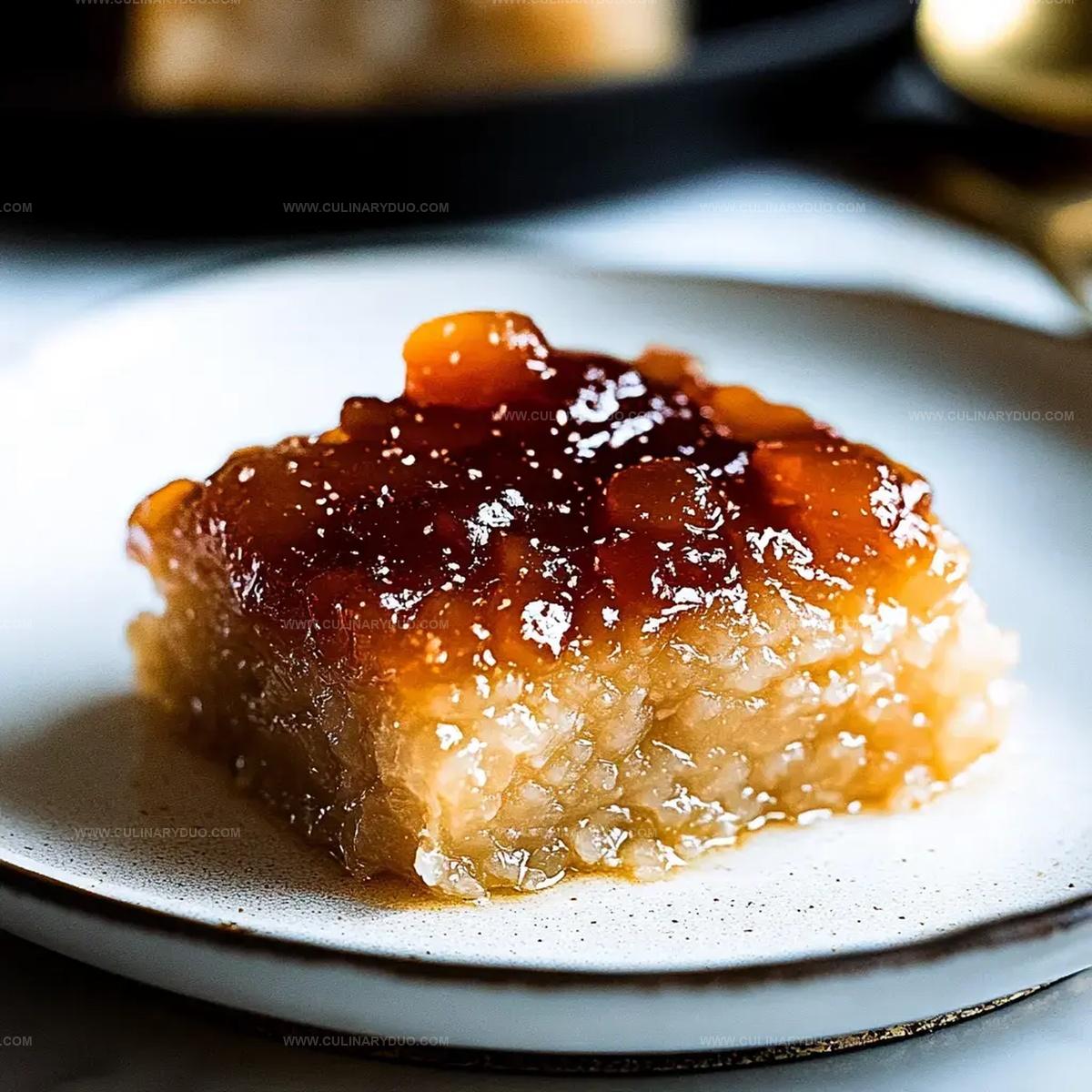Irresistible Biko Sticky Rice Recipe for Sweet Treat Lovers
Crafting an authentic biko sticky rice demands passion and a touch of culinary magic that connects generations.
Sweet coconut milk transforms simple ingredients into a Filipino dessert beloved across kitchens.
Glutinous rice becomes a canvas for rich, creamy flavors that dance on your palate.
Family gatherings always spark excitement when this classic treat emerges from the kitchen.
Soft, chewy textures blend perfectly with caramelized coconut milk’s golden embrace.
Traditional techniques passed down through decades ensure each bite carries a story of comfort and love.
One taste transports you to warm memories of shared moments and celebration.
Dive into this recipe and let the delicious journey begin!
Sweet Coconut Rice Cake For Comfort Food Cravings
What You’ll Need For Filipino Sticky Rice Cake
Main Rice Ingredient:Sweetening and Liquid Ingredients:Topping and Garnish Ingredients:Steps To Make Sweet Coconut Rice Cake Right
Step 1: Wash and Cook Glutinous Rice
Thoroughly rinse the glutinous rice under cool running water until the water becomes completely clear.
Transfer the rice to a rice cooker or pot and cook until it reaches a soft, fully cooked consistency.
Step 2: Create Creamy Coconut Syrup
In a large saucepan, blend together:Gently simmer the mixture over medium heat, stirring consistently until it transforms into a thick, luxurious syrup, which takes approximately 8-10 minutes.
Step 3: Merge Rice and Syrup
Pour the cooked rice into the prepared coconut syrup.
Cook on low heat, stirring constantly to prevent sticking.
Continue cooking until the mixture becomes incredibly thick and wonderfully sticky, typically taking 10-15 minutes.
Step 4: Craft Golden Latik
Heat coconut cream in a pan, allowing it to slowly reduce and develop beautiful golden brown curds.
Carefully strain the latik, separating the crispy bits from the liquid.
Set the golden curds aside for topping.
Step 5: Prepare and Finish Dessert
Transfer the sticky rice mixture into a well-greased 9×9 inch baking pan.
Sprinkle the golden latik over the top, and if desired, add an extra dusting of brown sugar.
Allow the dessert to cool completely before slicing into delectable squares.
Tips For Tender Filipino Coconut Sticky Rice Cake
Coconut Rice Cake Flavors For Dessert Fans
Serving Filipino Sweet Rice Cake With Flair
How To Store Sweet Coconut Rice Cake Best
FAQs
A special type of short-grain rice with high starch content that becomes very sticky when cooked, perfect for traditional Filipino desserts like this sweet coconut rice cake.
No, regular rice won’t work. Glutinous rice has unique properties that create the signature sticky texture essential to this dessert.
Yes, the ingredients are naturally gluten-free, making it a safe option for people with gluten sensitivities.
Latik has a rich, nutty caramel flavor created by slowly cooking coconut cream until it forms golden brown coconut curds, adding depth to the rice cake’s sweetness.
Print
Biko Sticky Rice Recipe
- Total Time: 55 minutes
- Yield: 8 1x
Description
Sweet Filipino Biko dessert celebrates rich cultural heritage with glutinous rice, coconut milk, and caramelized brown sugar topping. Creamy layers and deep brown hue invite dessert enthusiasts to savor traditional Philippine comfort in each delightful bite.
Ingredients
Main Ingredients:
- 2 cups glutinous rice (malagkit)
- 1 can (13.5 ounces / 400 milliliters) coconut milk
- 1 cup brown sugar
Liquid Ingredients:
- 2 1/4 cups (540 milliliters) water
- 1/2 cup (120 milliliters) coconut cream for latik
Seasoning:
- 1/2 teaspoon salt
- 2 tablespoons brown sugar for topping
Instructions
- Thoroughly rinse glutinous rice under cold water until the liquid becomes transparent, ensuring all excess starch is removed.
- Cook the rice in a rice cooker or pot using precise water measurements until fully tender and completely absorbed.
- In a large saucepan, blend coconut milk, brown sugar, and salt, heating over medium temperature and continuously stirring until the mixture thickens and develops a rich, glossy consistency, approximately 8-10 minutes.
- Gently incorporate the cooked rice into the coconut syrup, reducing heat to low and stirring consistently to prevent sticking and ensure even coating.
- Continue cooking the rice mixture, maintaining low heat, until it transforms into a dense, adhesive texture with minimal liquid remaining, roughly 10-15 minutes.
- Simultaneously prepare latik by simmering coconut cream, allowing it to gradually reduce and develop golden-brown caramelized curds.
- Carefully strain the latik, reserving the crispy coconut fragments as a garnish.
- Transfer the sticky rice mixture into a pre-greased 9×9 inch baking pan, spreading evenly and smoothing the surface.
- Generously sprinkle the reserved latik over the surface, adding an optional dusting of additional brown sugar for enhanced sweetness.
- Allow the coconut rice cake to cool completely at room temperature before cutting into desired serving portions.
Notes
- Choose high-quality glutinous rice for authentic sticky texture and traditional Filipino taste.
- Rinse rice thoroughly to remove excess starch, ensuring a cleaner and more refined final dessert.
- Use fresh coconut milk for richer, more intense coconut flavor that elevates the entire dish.
- Monitor syrup carefully during cooking to prevent burning and achieve perfect caramelized consistency.
- Adjust heat when combining rice and syrup to prevent sticking and ensure even coating.
- Toast latik slowly for deep golden color and nutty, caramelized flavor without burning.
- For gluten-free version, confirm all ingredients are certified gluten-free.
- Cool completely before cutting to maintain clean, sharp cake slices.
- Store in refrigerator, covered, for up to 3 days to maintain moisture and texture.
- Prep Time: 15 minutes
- Cook Time: 40 minutes
- Category: Desserts, Snacks
- Method: Simmering
- Cuisine: Filipino
Nutrition
- Serving Size: 8
- Calories: 377
- Sugar: 36 g
- Sodium: 124 mg
- Fat: 14 g
- Saturated Fat: 12 g
- Unsaturated Fat: 2 g
- Trans Fat: 0 g
- Carbohydrates: 61 g
- Fiber: 2 g
- Protein: 4 g
- Cholesterol: 0 mg


Michael Reyes
Founder & Lead Recipe Developer
Expertise
Education
Santa Fe Community College
Michael’s love for cooking runs deep, rooted in the bold, colorful flavors of his New Mexico upbringing.
After earning his Culinary Arts Certificate from Santa Fe Community College, he spent years sharpening his skills in kitchens that celebrated traditional Southwestern and Latin American dishes.
He believes cooking should feel approachable and fun, never complicated. When he’s not stirring up new recipe ideas, Michael’s out hiking scenic trails, chatting with farmers at local markets, or chasing the perfect sunset shot for inspiration.